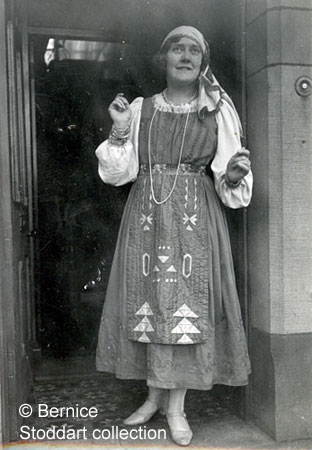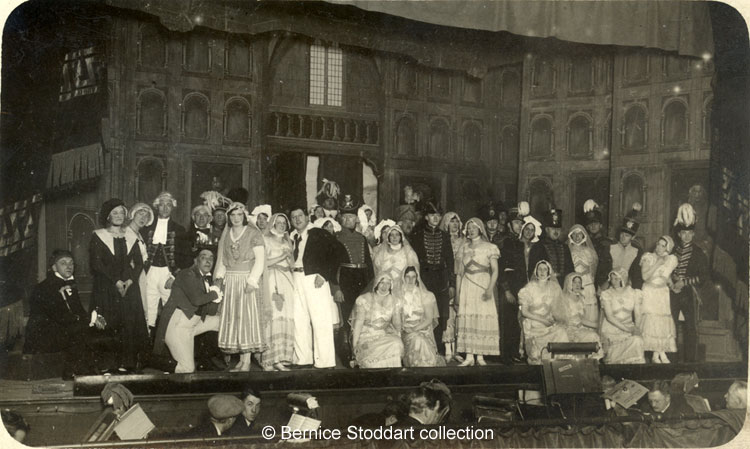Ruddigore is a tale of a family curse, with whoever held the
baronetcy of Ruddigore having to commit a daily crime, or perish.
The Society performed the Gilbert and Sullivan two act comic
opera at the Cinema House in February 1931. The producer was
Warren Jones, who was given just five weeks notice to prepare
the show. The orchestra, who can be seen in the orchestra pit,
was largely recruited from Derby[1].
The conductor's music stand has the score in readiness, with
"COND" across the corner.
Here are two slightly different photos of the cast from that year,
the second of which has been divided into three sections to enlarge
it (below).
| |
|
Cast members with specific parts:
Mortals:
A. B. Warren Jones (Sir Ruthven Murgatroyd, or Robin Oakapple)
Henry Askew (Richard Dauntless)
Sam Fowkes (Old Adam Goodheart)
A. J. Fowkes (Sir Despard Murgatroyd)
Mrs. Myfanwy M Wilks (soprano) (Rose Maybud)
C. Clare Smith (Mad Margaret)
Florence A. Hudson (Dame Hannah)
Inez Tinti (Zorah)
Vera Swann (Ruth)
Ghosts:
B. Hobbs (Sir Rupert)
A. H. Ormen (Sir Jasper)
G. B. Evans (Sir Lionel)
J. Walters (Sir Conrad)
H. Boden (Sir Desmond)
F. Matthews (Sir Gilbert)
P. Williamson (Sir Mervyn)
Mr. Jack Woodhead (bass) (Sir Roderic Murgatroyd)
The chorus was made up of
33 males and female singers, including some of the male ghosts
above and women such as Jessie Agutter, Evie Gentle and Bernice
Hardstaff who were still members of the society over
20 years later.
After the evening performance on the 11th February the Derby
musicians and some of the show's actors travelled home on
a private omnibus during a heavy snow storm. They
had a trying ordeal as the vehicle ploughed through snowdrifts
and snow was plastering
itself against the windscreen so the driver was unable to
see the road. They all had to wait at Whatstandwell until
the storm abated.
The annual ball was held on the evening of the 16th February,
and the principals and members of the chorus
who went wore their "Ruddigore" costumes[2],
something they didn't do in later years.
When the accounts for the show were published in April the
same year the balance sheet showed a loss just over £72,
with the largest single outgoing being the hire of the cinema
(£84). Over the years the society had sometimes paid professional
singers and in 1931 two of the cast, H. Askew and J. Woodhead,
were paid a fee for performing[3].
|

|
The characters Dame Hannah and Sir Roderic
Murgatroyd are standing at the extreme left, above. In the
centre are Sir Despard Murgatroyd and Mad Margaret.
Another character, Richard Dauntless, is on their right. |

|
The characters Sir Ruthven and Rose Maybud
are holding hands on the right
of the photo, above. Amongst the professional bridesmaids
was Bernice Hardstaff (front, 2nd from left). |

|
More bridesmaids, bucks and ancestors. |
 The
Yeomen of the Guard, 1932 The
Yeomen of the Guard, 1932
Producer Mr. A. Warren Jones
Musical Director Mr G. W. Johnstone
Having been deprived of their normal venue and despite what critics
said were "the
handicap of
difficult times and an inferior building"[4],
the Society staged six performances of The Yeomen of the Guard at
the Grand Pavilion, Matlock
Bath. Whilst some were highly critical
of the Pavilion, the theatre critic of The Derbyshire Times believed
it was admirably adapted for the opera. Its acoustics were good,
the stage and dressing room far better than any other local venue,
it was warm and cosy, the lighting excellent and the caretaker made
it spick and span![5] The
company played for the sixth time, their final performance, to a
crowded house[6].
There are no photographs for this production currently available.
 The
Chocolate Soldier, 1934 The
Chocolate Soldier, 1934
After a gap of two years, the Operatic Society returned to the Cinema
House for their 1934 production. The Chocolate Soldier, composed
by Oscar Straus in 1908, was based on George Bernard Shaw's play
Arms and the Man (1894).
The show's producer was Warren Jones and the musical director was
Mr. W. G. Johnstone[7].
The operetta is set in 1885. Serbia and Bulgaria are at war. It begins
with Bumerli, the Serbian Chocolate Soldier, climbing into Nadina
Popoff's bedroom to escape capture. Instead of bullets his ammunition
pouch contains only chocolate. These were replaced by caramels in
the Matlock production as, presumably, there would be less of a problem
with them melting under the footlights.
Seven of the principals can be seen above in the third act, when
Bumerli returns and is challenged to a duel. From left to right,
they are:
Miss Jess Dickinson (Mascha),
Vincent Hobbs (Sergeant Massakroff),
Sam Fowkes (Colonel Popoff),
A Stanley Morton (Major Alexius Spiridoff),
E O Simms (Bumerli, the Chocolate Soldier),
Mrs Lorna Mosley (Nadina Popoff),
Mrs Lottie Housley (Aurelia Popoff).
Other principal parts were played by Mr. Vincent Watson (Stephan),
Mrs Jessie Agutter (Katinka).
The eight cast members in the second photo are wearing traditional
costumes. Whilst the names of the men are currently unknown,
the dancers are Dorothy
Bowler (kneeling front, left), Vida Frith (back row,
2nd from the left), Mabel Walker (back row, 2nd from the right)
and Bernice Hardstaff, who is kneeling
on the right.
The show has fewer songs for the chorus than
other productions but they made their utmost of their few appearances,
according to the theatre critic of the Derby Daily Telegraph[7].
He was full of praise for all the soloists and thought "the
Masha of Miss Jess Dickinson, seen right, "a
fine study of an impish temptress, and her acting and singing
are good". He was reviewing the show's first night, commenting
that it had attracted a large audience[7]. |
|
 |
It was customary, at
least in the 1930s, for the entire cast to be presented with
a bouquet of flowers on the last night of opera week. Some
thought it rather too much, but it is probable that the recipients,
some of whom may never have been given flowers before, really
appreciated the gesture[8].
The floral display shown on the left were presented to a "Chocolate
Soldier" cast member, and were on display in the
family home of Bernice Hardstaff.
On the back is a note, written by Bernice:
"This is the only one of my Opera Flowers that came
out, March 1934".
Rather amazingly, some remnants survive today
but are now extremely fragile. |
|
 |
 The
Quaker Girl, 1935 The
Quaker Girl, 1935
Producer Edmund Ashley
Musical Director Mr G. W. Johnstone
The society was said to have scored one of its greatest triumphs
with its production of "The Quaker Girl",
also performed at the Cinema House. "Several artists enhanced
their local reputation" and Miss Inez Tinti was lauded as "the
success of the evening" in the title role. "The Quaker
Girl contains 50 per. cent more dialogue than the usual run of musical
comedies ... There were over 50 performers, and when they were all
on [stage] together it was a work of art to move gracefully among
the intervening scenery and stage properties"[9].
 |
Some of the principals, from the left: Mrs. Lottie Housley
(Madame Blum, a Parisien modiste),
Miss Inez Tinti (Prudence, the Quaker Girl),
Mr. E O Simms (Tony Chute, the best man),
Miss Lorna Mosley (Princess Mathilde) and Mr Gill Hudson (Captain
Charteris).
|
Act 1 - the exterior of an English country hostelry
Act 2 - Paris. Interior of Mme Blum's dressmaking salon
Act 3 The Pre Catalan. Outside Paris.
Mathilde is an exiled French princess, staying incognito
at the Chequers Inn before her marriage to a King's Messenger
from the Paris embassy. But, of course, the secret leaks.
Then Prudence, who is in disgrace for thinking worldly things,
meets Tony (a naval attaché at the American Embassy, Paris)
and is expelled from the fold for drinking a toast to the happy
pair after the wedding. She goes to Paris to stay with Madame Blum
...
 |
The chorus, with three of the principals. In the centre are:
Mr. A. Stanley Moreton (Quaker Pym/Prince Carlo, fiancé of
Princess Mathilde),
Mrs. Jessie Agutter (Rachel Pym) and Inez Tinti (the Quaker
Girl). |
Others in principal roles were played by:
Miss Jess Dickinson (Phoebe, Princess Mathilde's maid),
Mr. S. Fowkes (Jeremiah),
Mr Vincent Hobbs (Chief of Police),
Miss Marie Wright (Toinette, Mme. Blum's employee)
Vincent Watson (Jarge, the village crier/Monsieur Duhamel)
Agnes E. Jackson (Mme Lukyn, Chequers Landlady)
Jessica Hazlewood (Diane, a Parisien actress)
Ernest E. Farnsworth (William, a waiter at the Inn).
 The
pupils' page of Matlock Modern School: Monthly Letter, March, 1935 informs
us that the girls were at the performance of The Quaker Girl on
13th February. They had also seen shows in previous years. The
pupils' page of Matlock Modern School: Monthly Letter, March, 1935 informs
us that the girls were at the performance of The Quaker Girl on
13th February. They had also seen shows in previous years.
|




















